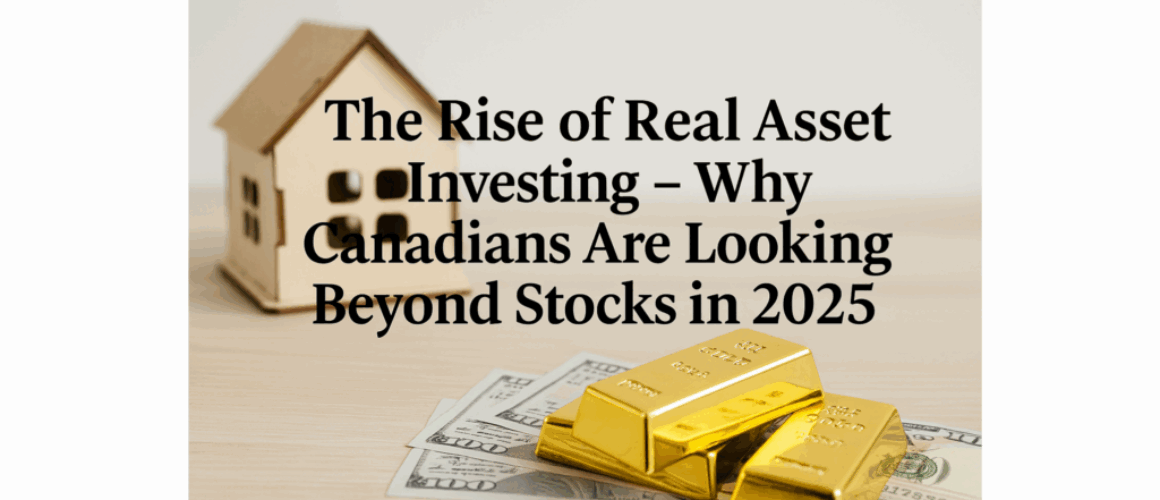The Rise of Real Asset Investing – Why Canadians Are Looking Beyond Stocks in 2025

For decades, Canadian retail investors were told to stick to the basics: equities, bonds, mutual funds. But in 2025, a new investment mindset is taking root — one that’s pushing everyday Canadians toward real assets like infrastructure funds, farmland, private credit, and even fractional real estate.
As volatility continues to plague stock markets, and bonds underperform in inflationary cycles, investors are looking for tangible, long-duration assets that offer both inflation hedging and consistent income. This marks a significant shift in the national investment psychology — from growth-at-all-costs to durability-first portfolios.
What Are Real Assets?
Real assets are physical or infrastructure-based investments that hold intrinsic value. These include:
-
Farmland
-
Energy infrastructure (pipelines, renewables)
-
Toll roads and ports
-
Private real estate (commercial, multifamily)
-
Commodities like timber and water rights
Many are now accessible through retail-focused investment platforms, REIT alternatives, and new private market funds designed for accredited and near-accredited investors.
Platforms like Harvest ETFs, Addy, and Fundscraper are democratizing access to projects that were once the exclusive domain of pension funds and family offices.
Why the Shift Now?
Several factors are driving the pivot toward real assets in Canada:
-
Persistent inflation is eroding fixed-income purchasing power.
-
Interest rate uncertainty is making traditional 60/40 portfolios unreliable.
-
Geopolitical risk is making physical control of resources and infrastructure more attractive.
-
Diversification pressure is pushing investors to reduce equity market correlation.
In short: people want stability with upside — and real assets provide that blend better than most financial instruments today.
“I’m not looking to beat the market,” says Vancouver-based engineer Jasbir Chahal, who recently invested in a renewable energy income trust. “I want returns I can see and understand — something that’s not vapor.”
Institutional Backing, Retail Acceleration
Large institutions have already validated the real asset thesis. Canada’s own CPP Investments has over $150 billion in real assets globally, and pension funds like OMERS and PSP Investments are increasing allocations to infrastructure and logistics platforms.
Retail investors are following — cautiously, but persistently. In 2025 alone, Canadian retail participation in real asset funds grew by 27%, according to the Financial Planning Standards Council.
Some products offer monthly income; others, equity participation. Many are RRSP- and TFSA-eligible, giving them a tax-advantaged edge over foreign alternatives.
Risks and Realities
Real asset investing is not risk-free. Liquidity is a major concern — unlike stocks, you can’t instantly sell your stake in a farmland co-op or a toll-road lease. Valuations may be opaque, and many products require minimum holds of 3–5 years.
Moreover, due diligence is critical. With the rise in demand, not all offerings are vetted equally. Investors must assess not only the asset class but also the operator, the cash flow model, and the exit mechanism.
“There’s a difference between owning a piece of a wind farm and being trapped in an illiquid, overpriced green fund,” warns Lara Desjardins, an alternative investment analyst in Montreal. “Smart real asset investing is about underwriting the operator as much as the asset.”
A Generational Perspective
What makes 2025 different is that younger Canadians are participating in real asset strategies. Millennials and Gen Z professionals — long priced out of homeownership and skeptical of market volatility — see fractional ownership and income-yielding physical assets as a way to reclaim financial agency.
For them, it’s not about beating the S&P. It’s about owning something real in a digital, inflated world.
Conclusion: From Charts to Concrete
In a financial era defined by complexity, real assets offer clarity. You can see them, touch them, and map their value to real-world utility. For Canadians navigating economic fog, that tangibility is becoming priceless.
Real assets may not be flashy, but they are foundational — and in 2025, that foundation is becoming a core part of Canada’s investment story.